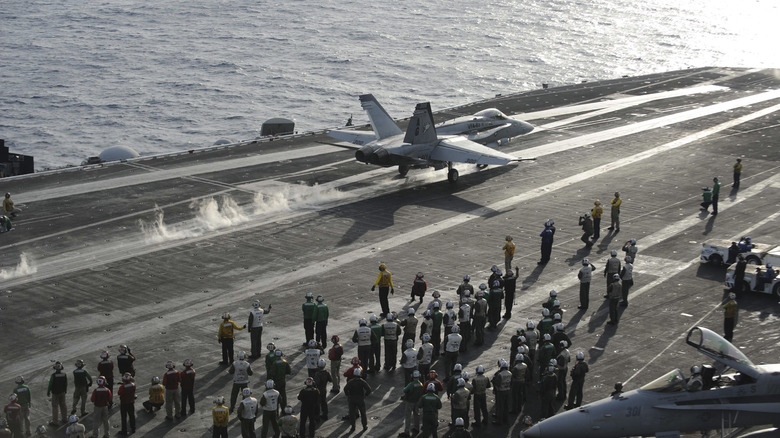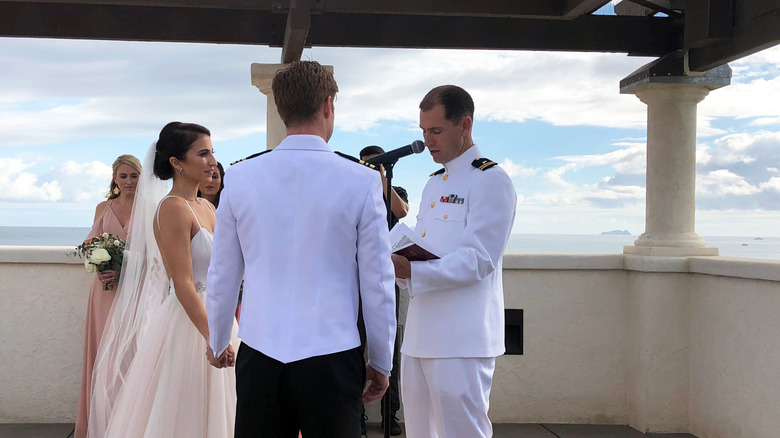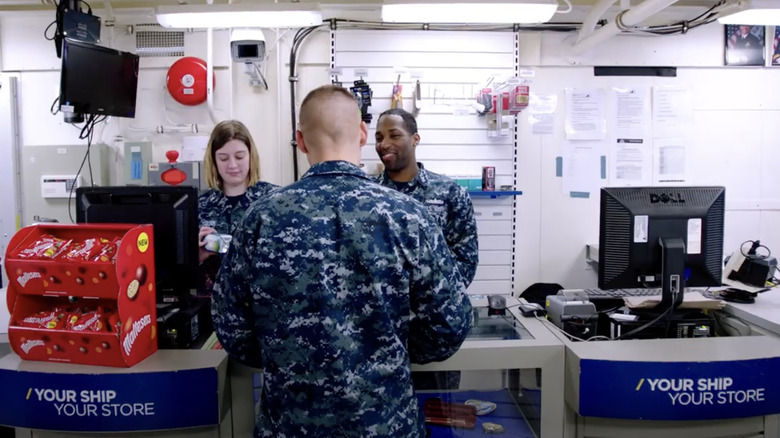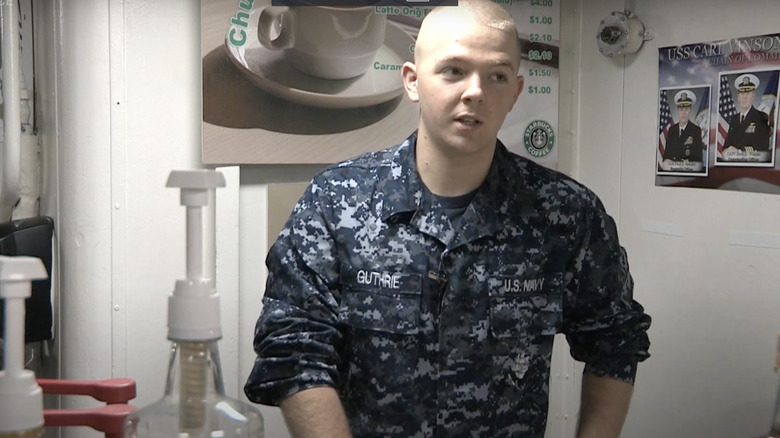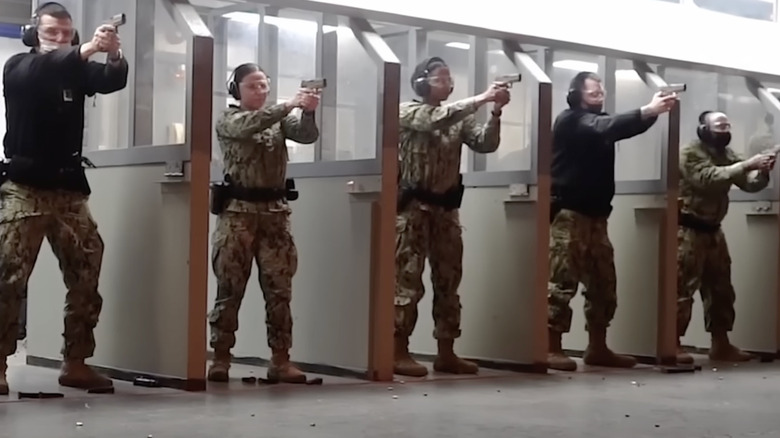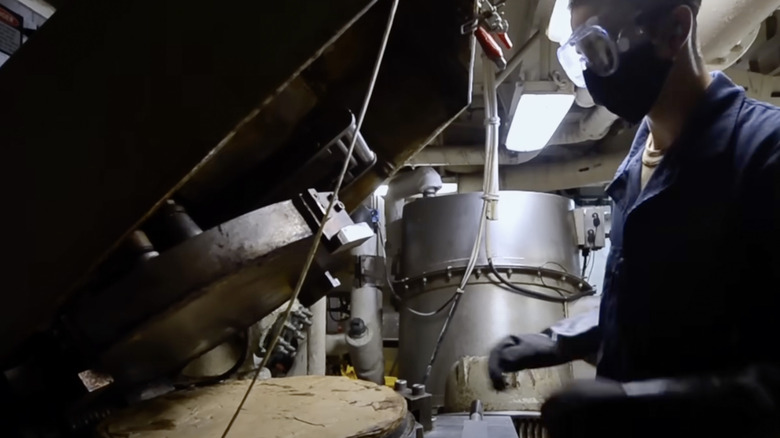Unexpected Jobs That Exist On A US Navy Aircraft Carrier
The U.S. Navy's first aircraft carrier was commissioned more than a century ago, and carriers have grown more capable and important in the years since. The Navy's fleet currently includes 11 aircraft and nine helicopter carriers, although some are in port for maintenance and upgrades at any given time. These massive ships require thousands of personnel to operate, from the flight deck workers who risk their lives and limbs to the galley personnel who keep the crew of several thousand people properly fed. Carriers also have fully functioning medical facilities on board, which employ doctors, pharmacists, phlebotomists, and lab technicians.
In addition, aircraft carriers require dozens of pilots and mechanics to keep their aircraft aloft and effective. Carriers usually stay at sea for months at a time, meaning they need to function as self-sufficient habitats for extended periods. This requires a staggering variety of jobs to be done on board, some of which you might not expect to be a part of a military endeavor.
Clergy on aircraft carriers must be versatile
In a community of thousands, there are bound to be folks of all religious persuasions, and members of the clergy serving at sea have to adapt to their crew's widely disparate needs. That means making efficient use of time and space, both of which are limited on an aircraft carrier. U.S.S. Nimitz Chaplain Charlie Mallie told WJCL in Savannah, Georgia that his on-board house of worship "is a generic space that can be rigged to accommodate any faith tradition that would need expression in the military."
Other personnel on the ship are responsible for non-religious counseling and other important tasks. Nimitz therapist Sherie Warner said, of her ship, "It's absolutely a small city, "We have subject matter experts on anything you can think of." That includes dentists, plumbers, electricians, retail clerks, and almost every other job function you'd find in a town of similar size on shore.
Retail Service Specialists cover everything from snacks to haircuts
Retail Services Specialists help provide a wide range of services to help crew members with routine tasks like laundry, banking, and even keeping service members' hair cut to military specifications. They are responsible for staffing and stocking on-board convenience stores and video game centers (yes, sailors get to play video games too). They also stock and handle the cash taken in from a ship's vending machines, and get five weeks of Class A training in Meridian, Mississippi on basic job tasks after boot camp.
Sailors who are interested in cutting hair can attend barber-specific "C" school once assigned to a ship, and that is just one of the skills a Retail Services Specialist can develop while serving that translates to job opportunities once they return to civilian life. Part-time sailors in the Navy reserves have similar opportunities on shore and are usually placed in jobs close to their homes.
Starbucks-trained baristas serve coffee drinks from a cafe in the mess hall
Like their civilian compatriots, many Navy sailors at sea need a bit of caffeine in the morning to get going. To provide for this need, the U.S.S. Carl Vinson has Chuckie's Cafe, an onboard coffee shop that serves up seven different Starbucks-branded drinks that would be familiar to any landlubber. Representatives from the Seattle-based chain came aboard to train the staff at Chuckie's, which is located in the carrier's mess hall. One crew member told Air Source Military, "We're all surprised that we actually have a Starbucks, that it actually tastes like Starbucks, and the prices are cheaper."
Chuckie's Cafe is staffed by Navy personnel and opens from 8:30-10:00 each morning and again for two afternoon shifts.
It's part of a large operation to provide a carrier's crew with food and beverages. The Military Show estimates that the mess hall staff aboard the U.S.S George H.W. Bush provides as many as 17,000 meals a day, which are carefully planned to provide variety and adequate nutrition.
The U.S.S. Nimitz has its own media production staff
That extends to media outlets. Nimitz media print shop director Jennifer Benedict told WJCL, "It is a small town and every small town has a small-town newspaper." She is a second-class Mass Communication Specialist, a job that requires a broad range of production skills across multiple forms of media.
The Navy also uses its on-board media staff to make videos like the one above on how fighter jets are launched from an aircraft carrier's flight deck. Media members on a carrier can also be responsible for assisting other on-board departments by producing graphics or other published materials. They can also assist the Navy's Department of Public Affairs by providing content to be used for recruiting or promotional purposes. MCSs also work with civilian media organizations on public relations efforts and conduct shipboard tours for various VIPS. After atending Boot Camp, potential MCS candidates go to Fort George G. Meade in Maryland for specialized training in photo and video journalism, news writing, and design.
Gunner's Mates are responsible for weapons-related training and maintenance
Although many of the crew and facilities on an aircraft carrier are dedicated to spiritual, intellectual, and gastronomical enrichment, a carrier's main function is still to wage war. This requires the crew to be trained on the safe and effective use of a wide range of defense tools. This critical job falls to Gunner's mates, who are responsible for everything weapon-related on the carrier. As you might expect, that includes the operations and maintenance of major weapons and defense systems like missile and radar launchers. In addition to keeping the ship itself ready for battle, Gunner's Mates are also responsible for training sailors on the safe and effective use of small arms. This training is conducted on the carrier's onboard firing range, and keeps sailors ready for potential face-to-face combat situations.
The Navy has about 4,500 Gunner's Mates, all of whom completed Class A Technical training of about four months before obtaining the specific credentials necessary to earn the post. Once assigned, they spend about 60% of their time at sea and the remainder at shore posts like weapons installations or ordnance storage facilities.
Disposing of a carrier's waste is a round-the-clock job for dozens of people
A bustling community of several thousand people produces large amounts of waste, so disposing of trash and recyclable materials is an important task on a mostly enclosed vessel. Much of the waste is processed to minimize its volume while an aircraft carrier is at sea. The U.S.S. Theodore Roosevelt offloads its waste materials to the U.S.S. Carl Vinson, where it is processed in incinerators and compactors. All plastic material is shredded and placed into a CMU, a piece of machinery that resembles a giant tortilla press.
The CMU seals the shredded plastic into large pucks, which are stored on board until the ship docks. The compressed discs are then sent off to be recycled. Aircraft carriers used to dump their waste into the water, but the Navy has become more sensitive to environmental concerns in recent years. Now only shredded food and paper waste are dumped overboard. According to Navy Productions, the branch's personnel processes more than 87,000 pounds of waste each month, and a carrier can generate 400 pounds of trash and recyclables for each hour of operation. That volume is handled by a staff of about two dozen temporarily assigned crew members and a handful of engineers working around the clock.
